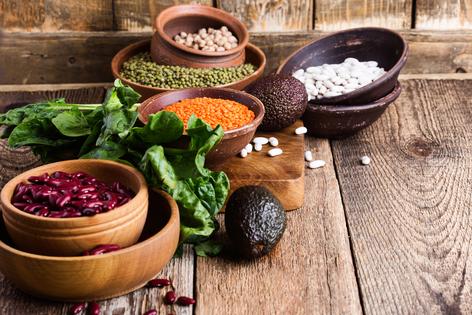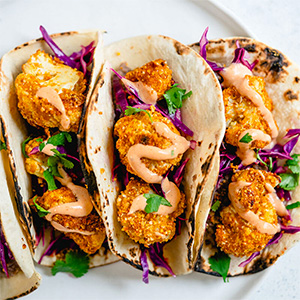Environmental Nutrition: Ready to eat more plants?
If you’ve considered transitioning to a more plant-based way of eating, there has never been a better time to start. Evidence from registered dietitians, scientists, and other experts supports the health benefits of eating more plants. Research shows cutting back on the amount of meat we consume can significantly impact the health of the planet as well.
Eating more plant foods and less meat is better on the budget and more accessible than ever with unlimited cooking and recipe resources and restaurant menu options. Ready to jump on board? EN has strategies and tips to help you get started.
What is plant-based?
There’s no official definition of plant-based, which is good news — you get to determine what it means for you. No set rules or restrictions make eating plant-based a sustainable eating pattern that caters to your needs.
At its most basic, plant-based means eating more whole plant foods like vegetables, fruits, whole grains, legumes, nuts, and seeds. Still, plant-based diets come in many forms, including vegan (no animal foods), lacto-ovo vegetarian (no animal flesh, but includes dairy and eggs), pescatarian (no animal flesh, but includes fish and seafood), and flexitarian (includes occasional animal foods and fish). Choose one of these plant-based diets, or design one that fits your lifestyle, preferences, and opinions — it’s that easy!
Explore your options
“Finding the diet plan that is right for you can help you make goals,” says Sharon Palmer, MSFS, RDN, The Plant-Powered Dietitian. “Many people find it easier to start out slow as they move towards eating a more plant-based diet,” Palmer explains. She suggests exploring the options by learning the basics in your environment, such as how to shop for plant-based ingredients in your neighborhood markets, nutritious meal planning, reliable recipes, cooking tips, and dining out options in your local restaurants and eateries.
“Once you’ve got the knack of doing it, then you can increase the number of days you eat plant-based,” says Palmer. This will help you learn your personal preferences and how to make eating plant-based your own.
Start where you are
Chances are you’re eating plenty of plant foods now. Count those as a head start toward increasing your plant intake. Breakfast foods like whole grain cereals, breads, and pancakes topped with fruit and fruit spreads, nuts, nut butters, and avocado are made with typical pantry ingredients, they’re easy to prepare, satisfying, delicious, and meatless.
Think of other favorite recipes that are also inherently meatless like whole grain pasta with marinara sauce or pasta primavera, soups like vegetable, bean, and lentil, and veggies like squash and eggplant stuffed with whole grains, nuts, and herbs. If recipes do have meat, dairy, or other animal product, it’s easy to swap them out for healthy plant substitutions like hearty, “meat-like” vegetables (mushrooms, squash, sweet potatoes), tofu, tempeh, seitan, and legumes (beans, lentils, peas, chickpeas) in place of meat, poultry, or fish; plant milks such as soy, oat, and almond instead of dairy milk; and nutritional yeast or vegan cheese for dairy cheeses.
Next steps
Try these tips from Sharon Palmer to begin your plant-based journey today.
Start with eating plant-based one day a week. Mondays are great because we often do shopping on the weekend and we’re all set for healthy eating and cooking.
Meal prep plant-based lunches a few times a week, such as grain bowls, stews, or casseroles.
Stock your pantry with staples, such as beans, whole grains, nuts and seeds and their butters, pasta, herbs and spices. Then add fresh foods — soymilk, fruits, veggies, bread — to your rotating shopping list.
Prime the pantry
Filling your pantry with healthy plant foods broadens your meal prep options and removes the temptation of less healthy items. Keep a variety of plant proteins on hand, such as legumes. Dried or canned beans, peas, lentils, and chickpeas are readily available, inexpensive, and canned varieties can be quickly and easily made into a meal. Whole grain foods, such as oats, brown rice, quinoa, breads, and pasta contain essential amino acids and several vitamins and minerals, including iron, magnesium, and zinc. Nuts and seeds and their butters provide healthy fats. Finally, keep a steady flow of seasonal fresh vegetables and fruits, as well as frozen and preserved. Strive to eat from each of these categories daily with as much variety as you can. More variety means more diverse vitamins, minerals, and plant compounds.
If you are significantly reducing animal products in your diet, Palmer says you need to supplement with vitamin B12, which is present in animal foods, but not plants. “Aside from that,” she says, “you can balance your diet wisely to get calcium, iron, and omega-3s through your choices, though supplements can help. It’s always a good idea to be prepared by speaking with a plant-based registered dietitian to make sure you are meeting your needs through diet.”
(Environmental Nutrition is the award-winning independent newsletter written by nutrition experts dedicated to providing readers up-to-date, accurate information about health and nutrition in clear, concise English. For more information, visit www.environmentalnutrition.com.)
©2025 Belvoir Media Group, LLC. Distributed by Tribune Content Agency, LLC.











Comments